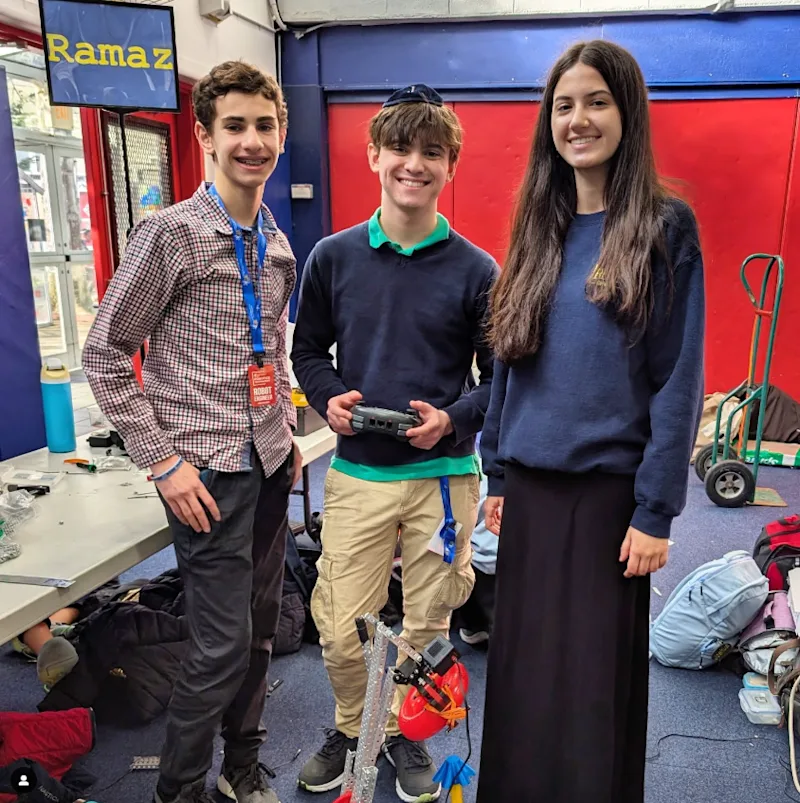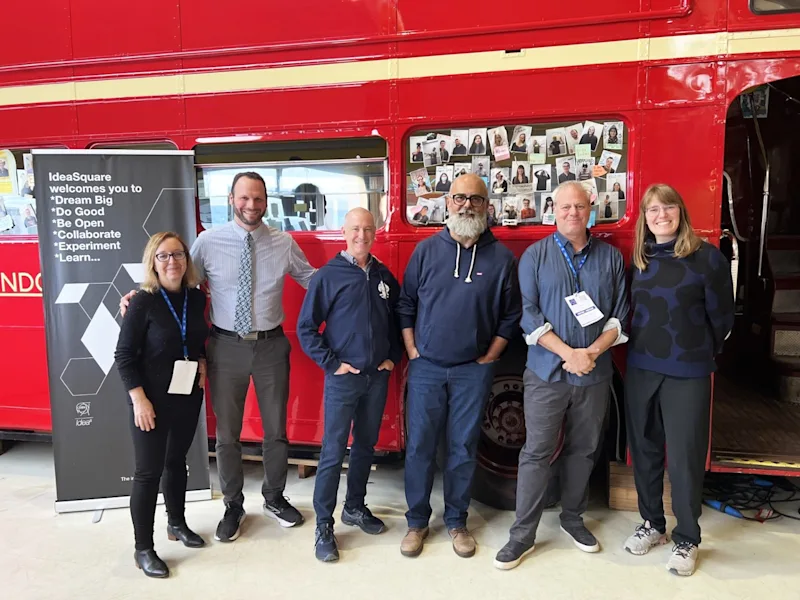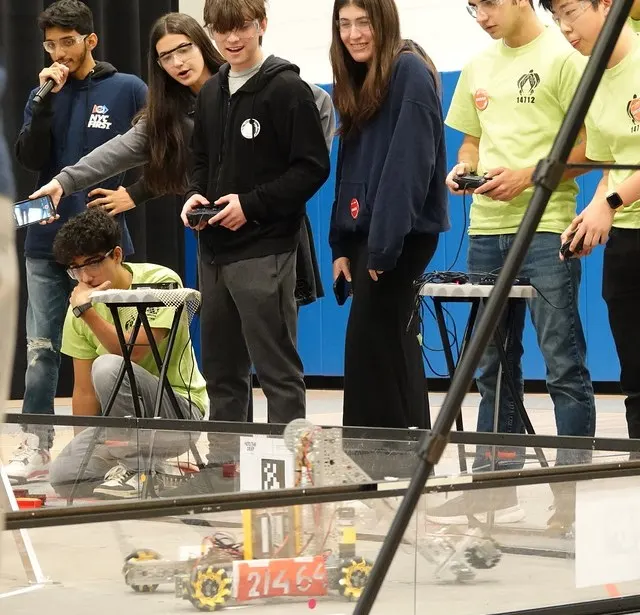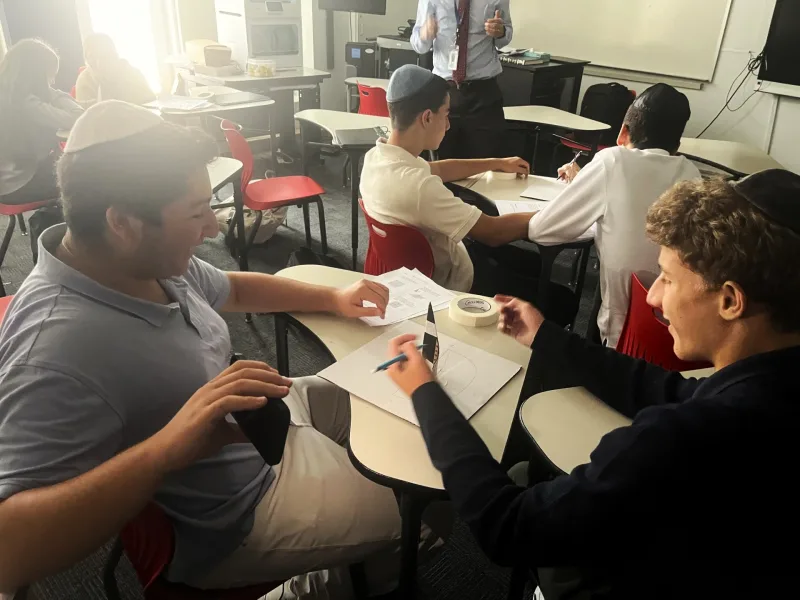
Rambots Think On Their Feet to Win Challenges at the CIJE Robotics Tournament
The Ramaz robotics team, the Rambots, learned a lot from the CIJE Robotics Tournament. The game was mainly based on picking up donut shape d-rings and placing the rings on stakes placed throughout the 12′ by 12′ playing field. The Ramaz team built an agile robot, which could move in all directions, including sideways! It had an arm and a claw, which could pick up the rings.
Challengingly, the team did not have these stakes in advance for practice. As soon as the students arrived at HAFTR, they grabbed a stake and attempted to place a ring, but the stake was a few inches too tall for the robot’s arm, and so wide at the bottom that the robot couldn’t get close enough to place the ring. Valiantly, the team, directed by Sami Rose F. ’26 and Francesca S. ’25, immediately borrowed a saw and made modifications. First, they cut back the front of the robot to get closer to the stakes. They proceeded to win the first round! The students continued to experiment and make small improvements each round. In the last round, programmer Elisha H. ’27 picked up the controls, racking up points before finally placing a ring on a stake and scoring the winning point!
The next CIJE competition is in March, and the Rambots are determined. Thanks to an anonymous donor, the team will purchase the game elements, which will allow them to practice and develop their robot with the actual game pieces prior to competition.

Four Ramaz Educators Journey to Geneva’s CERN IdeaSquare Conference
Ramaz faculty members traveled all the way to the prestigious CERN IdeaSquare educational center in Geneva, Switzerland for unparalleled professional development. Head of N-8 Ruth Gafni and technology teachers David Aronson, Andy Greenspan, and Joshua Rothman learned fascinating techniques to incorporate into the educational approaches at Ramaz. They explored AI, environmental impacts of technology, and more. Three pillars comprise the “thinking like CERN” approach, which was a continual focus of the conference. The first is “Anticipation,” utilizing research and open communication to anticipate problems and progress on the horizon. Second is “Order of Magnitude Thinking,” aiming for ideas and problem solving to have exponentially-growing impact, thus creating profound progress that remains relevant for a long time. Lastly is “Challenging Assumptions,” continually reevaluating preconceived notions to ensure the most effective innovation possible. The insights these educators gained from the conference, and the relationships they built with some of the world’s most cutting-edge thinkers, will greatly enhance school curricula and bolster Ramaz’s ongoing commitment to academic excellence.
This professional development experience was sponsored by an anonymous donor.

Ramaz Competes in the FTC International Robotics Competition
The Upper School robotics team, the Rambots, participated in the 2024-2025 season’s first FTC competition. FTC (First Tech Challenge) is an international robotics competition that evaluates teams on robot engineering, teamwork, community outreach, and problem-solving skills. Over the past few months, the Rambots have worked together to acquire parts, assemble their robot, and program it. This is the third year that Ramaz has competed in FTC, and the students delivered their best performance yet, advancing all the way to the playoff round! The competition was an incredible opportunity for the students to practice thinking on their feet and quickly solving problems, whether it was addressing a robot malfunction or adjusting their game strategy. It was also a lot of fun to meet teams from other schools and gain insights to help them improve for future competitions. They are looking forward to the next competition, on December 8.

Technology and Talmud Intertwine as Students Construct Sundials for Zmanim
Technology teacher Mr. David Aronson joined Rabbi David Fried’s Talmud class to teach a fascinating lesson that integrated engineering and Judaic Studies. The students were learning about zmanim (Halachic times) and, to enhance this unit, they constructed their own cardboard sundials! Using their phone flashlights as the sun, they replicated the sun’s path at the equinox and divided the day into 12 hours using colored pencils. Then, they marked the times for prayer. After finishing this process for the equinox, they were challenged to do the same for the winter and summer solstices. The students enjoyed the hands-on lesson and commented that the activity made the often-complicated system of zmanim seem so much simpler.

